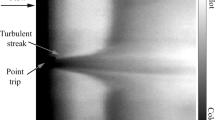Abstract
Tomographic techniques have great abilities to interrogate the combustion processes, especially when it is combined with the physical models of the combustion itself. In this study, a data fusion algorithm is developed to investigate the flame distribution of a swirl-induced environmental (EV) burner, a new type of burner for low NOx combustion. An electric capacitance tomography (ECT) system is used to acquire 3D flame images and computational fluid dynamics (CFD) is applied to calculate an initial distribution of the temperature profile for the EV burner. Experiments were also carried out to visualize flames at a series of locations above the burner. While the ECT images essentially agree with the CFD temperature distribution, discrepancies exist at a certain height. When data fusion is applied, the discrepancy is visibly reduced and the ECT images are improved. The methods used in this study can lead to a new route where combustion visualization can be much improved and applied to clean energy conversion and new burner development.
Similar content being viewed by others
References
Tică A, Guéguen H, Dumur D, et al. Design of a combined cycle power plant model for optimization[J]. Applied Energy, 2012, 98(5): 256–265.
Polyzakis A L, Koroneos C, Xydi G. Optimum gas turbine cycle for combined cycle power plant. Energy Conversion & Management, 2008, 49(4): 551–563.
Modesto M, Nebra S A. Exergoeconomic analysis of the power genera-tion system using blast furnace and coke oven gas in a Brazilian steel mill[J]. Applied Thermal Engineering, 2009, 29(11–12): 2127–2136.
Waterfall RC He R, Wolanski P. (2001). Flame visualizations using electrical capacitance tomography (ECT). Proc. SPIE, 4188, 242–250. (doi: 10.1117/12.417170)
He R, Xie C G, Waterfall R C. (1994). Engine flame imaging using electrical capacitance tomography. Electronics Letters 30, 559–560. (doi: DOI: 10.1049/el:19940406)
Liu S, Chen Q, Xiong X, Zhang Z and Lei J. (2008). Preliminary study on ECT imaging of flames in porous media. Measurement Science and Technology 19, 1–7. (doi: 10.1088/0957-0233/19/9/094017)
Ye Z R. 2014 Volumetric and Planar Electrical Capacitance Tomography. PhD thesis. University of Bath, UK.
Soleimani M, Mitchell CN,, Banasiak R and Wajman R. (2009). Four-dimensional electrical capacitance tomography imaging experimental data. Progress in Electromagnetics Research, PIER 90, 171–186.
Warsito W and Fan LS. 2003, 3D-ECT Velocimetry for Flow Structure Quantification of Gas-Liquid-Solid Fluidized Beds. Canadian Journal of Chemical Engineering, 81, 985-884.
Zbigniew Gut and Piotr Wolanski. (2010). Flame imaging using 3D electrical capacitance tomography. Combustion Science and Technology, 182, 1580–1585.
Liu J, Liu S, Zhou W, et al. Sensing flame structure by process tomography.[J]. Philosophical Transactions of the Royal Society A Mathematical Physical & Engineering Sciences, 2016, 374(2070).
Teng J, Snoussi H, Richard C. Decentralized variational filtering for simultaneous sensor localization and target tracking in binary sensor networks[C], Taipei, China, 2009: 2233–2236.
Acknowledgement
The authors wish to extend their gratitude to the State Administration of Foreign Experts Affairs for supporting the project ‘Overseas Expertise Introduction Program for Disciplines Innovation in Universities’ (ref: B13009), as well as the National Natural Science Foundation of China projects (61571189, 61503137, 61305056).
Author information
Authors and Affiliations
Additional information
Financially supported by State Administration of Foreign Experts Affairs for supporting the project ‘Overseas Expertise Introduction Program for Disciplines Innovation in Universities’ (ref: B13009), as well as the National Natural Science Foundation of China projects (61571189, 61503137, 61305056).
Rights and permissions
About this article
Cite this article
Liu, J., Liu, S., Sun, S. et al. Tomographic data fusion with CFD simulations associated with a planar sensor. J. Therm. Sci. 26, 175–182 (2017). https://doi.org/10.1007/s11630-017-0927-6
Received:
Published:
Issue Date:
DOI: https://doi.org/10.1007/s11630-017-0927-6




